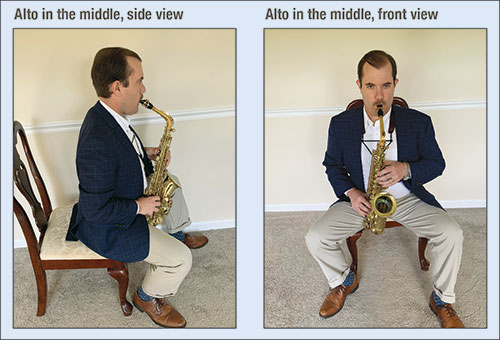I have given saxophone clinics to students and directors throughout the country. These sessions frequently include questions about embouchure, sound and technique development, vibrato, and literature. I am often asked where the saxophone should go when the student is seated: the middle or the side. This topic lacks a one-size-fits-all answer, but there are best practices that position students to play their best.
Basic Guidelines
Any conversation about saxophone placement should acknowledge that ideal placement allows students to play in the most efficient manner, while minimizing strain and tension. Any other purpose for altering placement is suspect, especially that of trying to achieve a uniform look among students in the band. Each young saxophonist is different, and the best practice for each may look a bit different.
Let’s examine the two accepted alternatives: to the side, with the saxophone resting on the outside of the student’s right thigh, and in the middle, with the saxophone between the legs and the Eb keyguard normally resting lightly on the inside of the right thigh.
In both descriptions, the saxophone rests somewhere on the student. Whether sitting or standing, a saxophonist should never hold out or support any weight with the hands. This will consistently produce tension and interfere with tone and technique development. Instead, any instrument position should begin with the neck strap fully supporting the weight of the instrument, pulled up so that the saxophone enters the embouchure with no further lifting. Then, the saxophone should rest on one of the two above points on the performer. Last, the top teeth anchor the head in place, assuring stable embouchure formation. At no time should the saxophone rest on any other item.
Which is Better?
In teaching music, it is easy to get trapped by the idea of a student progressing through defined phases of development. While this is true for some aspects of saxophone performance, instrument placement is a more slippery matter. While nearly all students should begin with the instrument placed to the side, not all should naturally progress to a position in the middle. Key factors in the decision include the height of the student, arm and torso size, and which member of the saxophone family is being played.
I am a 5’10" professional who has played for nearly 25 years. I find it most comfortable to perform with the alto in the middle. However, I play tenor and baritone to the side. In fact, all but the tallest saxophonists (perhaps 6’2" and above) are far more comfortable and tension-free with the tenor to the side. I have never seen a performer playing with the baritone in-between that I thought was the right choice.
There is no ideal height to determine when a student should to switch to the middle. Some may say 5’2" or 5’4", but any approximation is usually based purely on Kentucky windage. There are smaller performers who feel most comfortable with the saxophone in-between, and giant professionals who excel by playing to the side. One of my mentors is a nearly 6′ tall, 60-year-old, world-renowned soloist and pedagogue and often prefers to play with the saxophone to the side.
Who Should Switch
Wrist, hand, and arm position are all important for optimal technique. Experiment by bending your wrist toward your body and wiggling your fingers. Repeat this exercise with the wrist bent back, then with the wrist angled to the right, and then to the left. Finally, with the arm and wrist in a straight line, wiggle the fingers a final time. Which was most comfortable and free of tension? For nearly everyone, the answer is when the arm and wrist are straight.
This information can determine the best position for a young player. If wrists are bent or collapsed, tension and sometimes pain can hinder performance. If you see a student with poor hand position, a rethinking of instrument placement is appropriate
If a student is playing to the side, experiment first with neck and mouthpiece angle before switching to the middle. Slight adjustments in both can yield great results for hand position. Only when none of this works, and the problem is caused by height or long arms, should the instrument be switched to between the legs.
A few areas should be checked to make sure that the switch to the middle is successful. Is the student resting the saxophone on the chair or their right wrist on their right leg? Is the right wrist collapsed in any way rather than being in a straight line with the arm? If so, the student should go back to playing to the side.
.jpg)

Considerations for Best Results
No matter which position is best for a student, each can be successful if certain conditions are met. For the side position, students should sit up straight, sitting closer to the edge of the chair than the back. Both feet should be planted on the floor. The mouthpiece and neck should be adjusted so that the instrument can go directly into the embouchure, with students looking straight ahead and no weight being supported in the hands.
After this, the primary concerns should be comfort and mobility in the hands and arms. Both hands should be in a relaxed C shape while the fleshiest parts of the fingertips are on the pearls, and again, the hands and arms should be in a straight line. All motion should begin at the large knuckle, not at any smaller joints in the finger. There should be no excess tension in either arm. Ask students if they can feel their elbows, a classic sign of tension. The arms and elbows should be relaxed, not rigid or pinned. A military bearing may look appealing, but it is detrimental to musculoskeletal health and flexibility.
Success in the Middle
When playing with the saxophone between the legs, students should sit on the edge of the chair and lean forward very slightly. Both feet will be flat on the floor, with the left foot slightly in front of the right. This position allows a free, open air passage. It also ensures that students can let the neck strap support the instead of the chair. Again, the hands should be curved and relaxed, in a straight-line with the arms. No collapsing should be observed, and students must not be resting any portion of their right arms on their right legs.
While some of these suggestions may seem like nitpicking, proper position can make student development faster. With the most comfortable, effective playing position, they can focus on tone, technique, and musicality, instead of fighting artificial barriers. They can also avoid bad habits that may impede their ability to play the saxophone. Small changes can produce significant progress.






